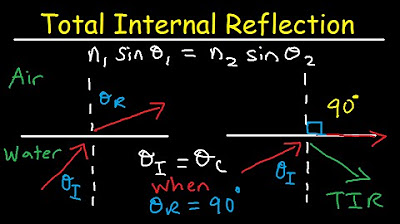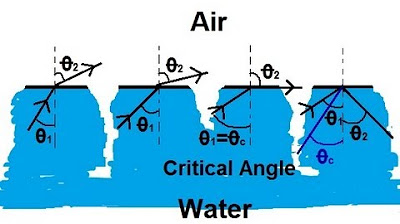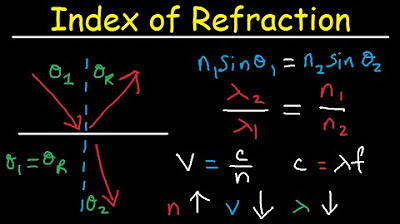Refraction of Light
TLDRThis video script delves into the concept of light refraction, explaining how light bends when transitioning between different media. It introduces key concepts such as the incident ray, reflected ray, and refracted ray, and illustrates them with a glass rod in water example. The law of reflection and Snell's law are discussed, with a step-by-step calculation of the refraction angle using the indices of refraction for air and water. The script also touches on the variation of light speed in different materials and the phenomena of critical angle and total internal reflection, providing a comprehensive understanding of these optical principles.
Takeaways
- 🌟 The refraction of light is the bending of light when it passes from one medium to another.
- 🔍 The refraction is visually demonstrated by a glass rod appearing bent at the interface between air and water.
- 📐 At the point of incidence, a light ray can reflect, refract, or be absorbed by the material.
- 🌈 Snell's Law (n1 * sinθ1 = n2 * sinθ2) is used to calculate the angle of refraction and the index of refraction.
- 🔢 The index of refraction for air is approximately 1, and for water, it is 1.33.
- 💡 As light moves from a low index of refraction material to a high index material, it bends towards the normal line.
- 🚀 The speed of light changes based on the medium it travels through, calculated as the speed of light divided by the index of refraction.
- 💎 In materials with a high index of refraction, like diamond, light travels slower compared to air or water.
- 🔄 When light moves from a high index material to a low index material, it bends away from the normal line.
- 📏 The critical angle occurs when the angle of refraction is 90 degrees, and it is specific for each medium interface.
- ✨ Total internal reflection happens when the angle of incidence exceeds the critical angle, with all light reflecting and none refracting.
Q & A
What is the refraction of light?
-The refraction of light is the property that causes light to bend when it passes from one medium to another.
What are the possible outcomes when a light ray strikes the boundary between two media?
-When a light ray strikes the boundary, it can reflect, refract, or be absorbed by the material.
What is the incident ray?
-The incident ray is the initial light ray that strikes the boundary between two media.
What is the law of reflection?
-The law of reflection states that the angle of incidence is equal to the angle of reflection.
What is Snell's law and how is it used?
-Snell's law, also known as the law of refraction, is used to calculate the angle of refraction or the index of refraction. It is expressed as n1 times sine of the angle of incidence (theta1) equals n2 times sine of the angle of refraction (theta2).
What is the index of refraction for air and how is it used in calculations?
-The index of refraction for air is approximately 1. It is used in calculations involving Snell's law to determine the angles of refraction and the speed of light in different media.
How does the speed of light change when it travels through different materials?
-The speed of light changes based on the material it is traveling in. It can be calculated using the formula speed equals the speed of light in a vacuum divided by the index of refraction of the material.
What happens when light travels from a material with a low index of refraction to a material with a high index of refraction?
-When light travels from a material with a low index of refraction to one with a high index, the ray bends closer to the normal line, decreasing its angle.
What is the critical angle and how is it determined?
-The critical angle is the specific incident angle at which the refracted angle is 90 degrees, causing the light ray to travel along the boundary between two media. It is calculated using Snell's law with the refracted angle set to 90 degrees.
What occurs when the angle of incidence exceeds the critical angle?
-When the angle of incidence exceeds the critical angle, total internal reflection occurs, meaning all of the light reflects off the boundary and none of it refracts.
How does the speed of light vary in materials like diamond and water?
-The speed of light decreases in materials with a higher index of refraction. For example, in diamond, which has a high index of refraction around 2.4, light travels more slowly compared to its speed in water or air.
What is the relationship between the index of refraction and the speed of light?
-The speed of light is inversely related to the index of refraction. In materials with a higher index of refraction, the speed of light is slower, and in materials with a lower index of refraction, the speed of light is faster.
Outlines
🌟 Introduction to Light Refraction
This paragraph introduces the concept of light refraction, explaining it as the bending of light when it passes from one medium to another. The video uses an example of a glass rod appearing bent at the interface between air and water to illustrate refraction. It explains the incident ray, reflected ray, and refracted ray, and how the angle of incidence is related to the angle of refraction according to the law of reflection. The paragraph also introduces Snell's Law, or the law of refraction, which is used to calculate the angle of refraction and the index of refraction. The index of refraction for air is approximately 1, and for water, it is 1.33. Using Snell's Law, the video demonstrates how to calculate the angle of refraction when light moves from air to water.
🌈 Speed of Light and Index of Refraction
This paragraph delves into the relationship between the speed of light and the index of refraction. It clarifies that the speed of light varies depending on the medium it travels through, with the speed of light in a vacuum being the highest. The video explains how to calculate the speed of light in different media by dividing the speed of light in a vacuum by the index of refraction of the medium. It provides examples of the speed of light in air and water, highlighting that light travels slower in materials with a higher index of refraction, such as diamond. The paragraph also explores what happens when light travels from a medium with a high index of refraction to one with a low index, causing the light to bend away from the normal line. It introduces the concept of total internal reflection and the critical angle, which occurs when the angle of incidence is such that the refracted ray would travel along the boundary between the two media.
🔍 Understanding Critical Angle and Total Internal Reflection
The final paragraph focuses on the critical angle and total internal reflection. It explains that when the incident angle equals the critical angle, the refracted ray travels along the boundary between the two media, which is a unique phenomenon. The video then demonstrates how to calculate the critical angle using Snell's Law, showing that it is a specific incident angle when the refracted angle is 90 degrees. The paragraph clarifies that while the incident angle can vary, the critical angle has a single value. It also discusses the occurrence of total internal reflection when the angle of incidence exceeds the critical angle, resulting in no refraction and all light reflecting back into the denser medium.
Mindmap
Keywords
💡Refraction of Light
💡Incident Ray
💡Normal Line
💡Snell's Law
💡Refractive Index
💡Angle of Incidence
💡Angle of Refraction
💡Speed of Light
💡Total Internal Reflection
💡Critical Angle
💡Index of Refraction for Different Media
Highlights
The focus of the video is on the refraction of light, a property that causes light to bend when passing from one medium to another.
A glass rod is demonstrated to be bent at the interface between air and water, visually showing the refraction of light.
The incident ray can reflect, refract, or be absorbed by the material at the boundary between two media.
According to the law of reflection, the angle of incidence is equal to the angle of reflection.
Snell's law, or the law of refraction, is introduced as a tool to calculate the angle of refraction or the index of refraction.
The index of refraction for air is approximately one, and exactly one for a pure vacuum.
The index of refraction for water is 1.33, which is used in the calculation of the angle of refraction.
The speed of light changes based on the material it is traveling in, which can be calculated using the speed of light divided by the index of refraction.
Light travels slower in materials with a higher index of refraction, such as diamond.
When light moves from a material with a low index of refraction to one with a high index, it bends closer to the normal line.
Conversely, when light moves from a material with a high index of refraction to one with a low index, it bends away from the normal line.
The critical angle is when the refracted angle is 90 degrees, and the light ray travels along the boundary between the two media.
Total internal reflection occurs when the angle of incidence is increased beyond the critical angle, causing all light to reflect and none to refract.
The calculation of the critical angle involves Snell's law and occurs at an incident angle where the refracted angle would be 90 degrees.
The video aims to improve understanding of light refraction, calculation of angles, and the phenomena of critical angle and total internal reflection.
Transcripts
Browse More Related Video

Total Internal Reflection of Light and Critical Angle of Refraction Physics

Refraction of Light

Physics 52 Refraction and Snell's Law (4 of 11) Total Internal Reflection: From Water to Air

Total internal reflection | Geometric optics | Physics | Khan Academy

Snell's Law & Index of Refraction - Wavelength, Frequency and Speed of Light

Snell's Law & Index of Refraction Practice Problems - Physics
5.0 / 5 (0 votes)
Thanks for rating: